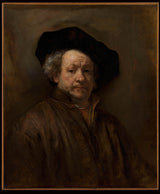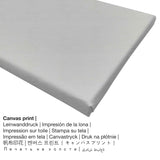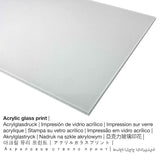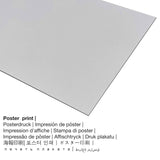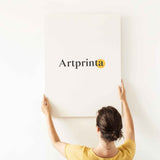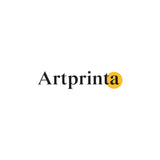Rembrandt van Rijn, 1660 - Foto nke onwe - mbipụta nka mara mma
Ụtụ gụnyere. Mbupu gbakọrọ na ndenye ọpụpụ.
Họrọ ihe ị ga-achọ inwe
N'ime ndepụta ndetu ngwaahịa ị nwere ike họrọ ihe na nha ọkacha mmasị gị. Ka ị kwekọọ n'ihe ị chọrọ nke ọma, ị nwere ike họrọ n'ime nhọrọ nhazi ngwaahịa ndị a:
- Bipụta na iko acrylic (nke nwere ezigbo mkpuchi iko): The acrylic glass print, which is sometimes described as a UV print on plexiglass, will transform an original into beautiful décor. Besides, it makes a distinct alternative to canvas or dibond fine art replicas.
- Mbipụta kanvas: A canvas direct print is a printed cotton canvas mounted on a wooden frame. A printed canvas makes a cosy, positive impression. A canvas of this work of art will allow you to transform your art print into a large size artpiece as you would see in a gallery. Canvas prints are relatively low in weight. That means, it is easy to hang your Canvas print without any wall-mounts. A canvas print is suited for all kinds of walls.
- Metal (aluminium debond mbipụta): Aluminium Dibond prints are prints on metal with a true depth. The non-reflective surface structure make a modern look. The Direct Print on Aluminum Dibond is the best introduction to art reproductions with aluminum. For our Direct Print On Aluminum Dibond, we print the chosen work of art onto the aluminium surface. Colors are luminous and bright in the highest definition, fine details are very clear, and the print has a a matte appearance that you can literally feel.
- Mpempe akwụkwọ ederede (akwa akwa akwa): A poster is a printed sheet of canvas paper with a granular finish on the surface, that reminds the actual artwork. The poster is qualified for framing the art copy in a personal frame. Please note, that depending on the absolute size of the canvas poster print we add a white margin between 2-6cm around the painting in order to facilitate the framing with a custom frame.
Nkwupụta iwu: We try everything to describe the products as accurate as possible and to exhibit them visually. At the same time, the colors of the printed materials and the printing can vary to a certain extent from the representation on your screen. Depending on the settings of your screen and the nature of the surface, not all color pigments can be printed one hundret percent realistically. Because all art reproductions are printed and processed manually, there might as well be minor variations in the motif's size and exact position.
What does the original artwork description of the The Metropolitan Museum of Art say about the 17th century artwork created by Rembrandt van Rijn? (© - Ụlọ ihe ngosi nka nke obodo ukwu - Museumlọ ihe ngosi nka nke Obodo)
Rembrandt was a dedicated self-portraitist all his life, and roughly forty self-portraits by him survive today. In this example, painted when Rembrandt was fifty-four, the artist was unsparing in depicting the signs of aging in his own face, building up the paint in high relief to convey his furrowed brow, the heavy pouches beneath his eyes, and his double chin. The recent removal of a synthetic varnish has revealed more of Rembrandt’s working method, showing for example how he flipped the brush to incise with its butt end the rough curls spilling out of his cap.
Banyere eserese aha ya Onyonyo
N'elu 360 afọ nka nka Onyonyo bụ onye omenkà kere ya Rembrandt van Rijn. Nke kariri 360 onye afọ mbụ nwere nha - 31 5/8 x 26 1/2 na (80,3 x 67,3 cm). Mmanụ na kwaaji was used by the Dutch painter as the technique for the painting. Moveover, the artpiece is included in the Ụlọ ihe ngosi nka nke Metropolitan digital art collection in New York City, New York, United States of America. With courtesy of - The Metropolitan Museum of Art, New York, Bequest of Benjamin Altman, 1913 (nwere ikike - ngalaba ọha). Na mgbakwunye na nke ahụ, ihe osise ahụ nwere akara kredit ndị a: Arịrịọ nke Benjamin Altman, 1913. Ọzọkwa, nhazi nke mmepụta dijitalụ bụ Eserese ma nwee oke akụkụ nke 1: 1.2, nke pụtara na ogologo bụ 20% mkpụmkpụ karịa obosara. The painter Rembrandt van Rijn was an artist from the Netherlands, whose art style can be classified as Baroque. The Dutch artist was born in 1606 in Leiden and died at the age of 63 in 1669 in Amsterdam.
Ozi ndabere na nka pụrụ iche
| Aha eserese ahụ: | "Ihe osise onwe" |
| Nhazi nka: | sere |
| Okwu mkpokọta: | nka ochie |
| oge: | 17th narị afọ |
| Afọ nka: | 1660 |
| Afọ nka: | ihe dị ka afọ 360 |
| Usoro izizi: | mmanụ na kwaaji |
| Akụkụ nke ihe osise izizi: | 31 5/8 x 26 1/2 na (80,3 x 67,3 cm) |
| Ụlọ ihe ngosi nka: | Museumlọ ihe ngosi nka nke Obodo |
| Ebe ngosi nka: | New York City, New York, Njikota Obodo Amerika |
| Weebụsaịtị nke ihe ngosi nka: | Museumlọ ihe ngosi nka nke Obodo |
| License: | ngalaba ọha |
| Site n'aka: | Ụlọ ihe ngosi nka nke Metropolitan, New York, Arịrịọ nke Benjamin Altman, 1913 |
| Ebe E Si Nweta: | Arịrịọ nke Benjamin Altman, 1913 |
Nkọwa akụkọ ahaziri ahazi
| Nkewa edemede: | ọrụ mgbidi |
| Usoro mmeghari: | dijitalụ mmeputakwa |
| Usoro nhazi: | Mbipụta UV ozugbo (mbipụta dijitalụ) |
| Production: | arụpụtara na Germany |
| Stockdị ngwaahịa: | mmepụta ihe na-achọ |
| Ihe eji eme atụmatụ: | ihe ndozi ụlọ, ụlọ mmepụta nka nka |
| Nhazi onyonyo: | usoro eserese |
| Oke akụkụ onyonyo: | 1: 1.2 |
| Nkọwa nke oke akụkụ akụkụ: | ogologo bụ 20% mkpụmkpụ karịa obosara |
| Ụdị akwa: | acrylic glass print (nwere ezigbo mkpuchi iko), mbipụta akwụkwọ mmado (akwụkwọ kwaaji), mbipụta ọla (aluminium dibond), mbipụta akwụkwọ. |
| Nhọrọ nha nke akwa akwa n'elu etiti ihe na-agbatị (mbipụta kwaaji): | 50x60cm - 20x24", 100x120cm - 39x47", 150x180cm - 59x71" |
| Mbipụta iko acrylic (nwere ezigbo mkpuchi iko) dị iche iche: | 50x60cm - 20x24", 100x120cm - 39x47", 150x180cm - 59x71" |
| Nhọrọ nha nke akwụkwọ mmado (akwụkwọ kwaaji): | 50x60cm - 20x24", 100x120cm - 39x47" |
| Mpempe aluminom (aluminium dibond ihe) nha: | 50x60cm - 20x24", 100x120cm - 39x47" |
| Nhazi mbipụta nka: | agunyeghi |
Ozi ndabere na onye na-ese ihe
| Aha onye nka: | Rembrandt van Rijn |
| okike nke onye nka: | nwoke |
| Nationality: | Dutch |
| Ọrụ nke onye na-ese ihe: | onye na-ese ihe |
| Obodo onye nka: | mba netherland |
| Nkewa onye nka: | nna ukwu ochie |
| Ụdị nka: | Baroque |
| Nwụrụ anwụ: | 63 afọ |
| A mụrụ: | 1606 |
| Ebe omuma: | Leiden |
| Nwuru: | 1669 |
| Nwụrụ na (ebe): | Amsterdam |
© Nchekwa ikike nwebisiinka, Artprinta.com (Artprinta)

